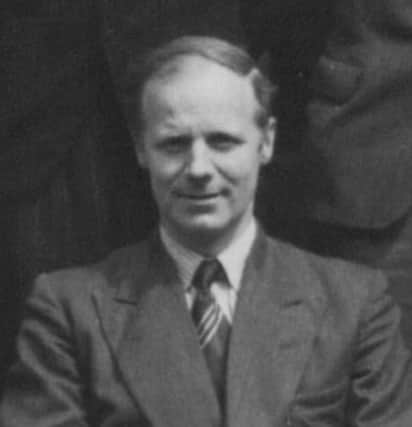Ulster-born husband and Welsh wife invented wartime technology


Gallantry and tragedy on the home front is remembered too. Countless tributes also go to army chaplains, medics, nurses and the many other trades, professions and specialities that war necessitates.
But sometimes scientists and inventors get less of a mention than they rightfully deserve, unless popular films like The Dam Busters mark the genius, inventiveness and dogged determination of people like Dr Barnes Wallis.
Advertisement
Hide AdAdvertisement
Hide AdDown the years Roamer’s page has regularly shared readers’ accounts of folk with local connections whose unique contribution to the war effort, particularly in medicine and technology, has been truly historic - yet sometimes overlooked.
Today brings an unusual tale - a husband and wife team whose scientific innovations profoundly influenced some of wartime’s most memorable epochs.
Their scientific work in peacetime was similarly remarkable, as was their devotion to academic and charitable causes, a tally of achievements that’s virtually unmatched.
Sir Samuel Crowe Curran, an eminent physicist and university administrator, and his scientist wife Dr Joan Elizabeth Curran (nee Strothers), worked in the development of the proximity fuse, which was largely responsible for the destruction of over 90% of the German V1 rockets aimed at Southern England in 1944.
Advertisement
Hide AdAdvertisement
Hide AdSir Samuel’s work on magneton transmitters resulted in a device that was fitted to all Bomber Command aircraft and to Coastal Command’s radar equipment.
His invention was vital in the Allied victory in the Battle of the Atlantic.
While he was devising an ingenious device that could detect the marauding German U boats that were cutting off Britain’s desperately-needed seaborne supplies, his wife Joan Curran, working in an adjoining laboratory, was methodically cutting up strips of tinfoil and developing the idea which came to be known as ‘Operation Window’ - the scattering of ‘metallic confetti’ in the path of enemy aircraft and disrupting their radar.
Joan was born on 26 February 1916 in Swansea, Wales.
Samuel was born in Ballymena on 23 May 1912, his mother Sarah (nee Crowe) having gone to her ancestral home so that Samuel could be born in Northern Ireland.
Advertisement
Hide AdAdvertisement
Hide AdSoon afterwards she returned with him to her husband and family in Wishaw, Lanarkshire, where Samuel was to spend the remainder of his childhood and youth.
He was essentially in speech and outlook, always a West of Scotland man.
He attended the local school, where he became head boy, and in 1929, at the age of 17, he entered Glasgow University, gaining a BSc and an MA with First Class Honours in Mathematics and Physics.
He joined the Physics Department as a PhD research student in 1934 and in 1937 moved to Cambridge for a second PhD.
Advertisement
Hide AdAdvertisement
Hide AdWorking in atomic physics he devised an improved Geiger counter and experimented with other techniques that would become hugely important in atomic research.
At the start of WWII Dr Curran joined the Royal Aircraft Establishment (RAE) at Farnborough and worked on the development of radar and the famous proximity fuse.
The fuse was one of the most important technological innovations of WWII - a secret that was guarded to a similar level as the atomic bomb or the D-Day invasion.
War historians will be better able to explain the device than Roamer (or than the News Letter reader who supplied the information about Samuel!) but it detonated explosives automatically, depending on the distance to the target.
Advertisement
Hide AdAdvertisement
Hide AdLike many British inventions, Dr Curran’s designs were forwarded to the U.S.A for development and production!
Samuel married Joan Strothers in November 1940, a marriage of 57 outstandingly happy years.
Joan was working on Operation Windows in a laboratory along the corridor where she invented ‘chaff’, a radar countermeasure technique that thoroughly confused enemy radar.
Like her husband, she also worked on the development of the proximity fuse and the electromagnetic isotope separation process for the atomic bomb.
Advertisement
Hide AdAdvertisement
Hide AdJoan tried various types of radar reflectors for the Windows project, including wires and sheets, before settling on strips of tin foil of one to two centimetres wide and 25 centimetres long that could be scattered from bombers, thus disrupting the enemy’s radar.
Windows was famously utilised in June 1944 by 617 Squadron to produce a ‘phantom invasion force’ of ships in the Straits of Dover, keeping the Germans baffled about the whereabouts of the Allied assault on Normandy.
And as one of the most original and effective military developments in World War II was the proximity fuse, made possible by Samuel, the Currans must surely be one wartime’s most historic scientific marriages!
Early in 1944 Samuel and Joan, with around 20 other British scientists, went to the USA to work on the Manhattan Project - the development of the atomic bomb.
Advertisement
Hide AdAdvertisement
Hide AdSamuel invented the ‘scintillation counter’ later to be used in almost every scientific laboratory in the world.
After the war Samuel and Joan returned to live in Scotland and in March 1955, working at the Atomic Weapons Research Establishment in Aldermaston, he helped develop Britain’s own hydrogen bomb.
Sir Samuel received the highest honours and acclaim for his many leading academic appointments and assignments in Scotland, the UK and around the world, and for the enormous, on-going, charity project for mental disability that he co-founded with his wife.
He died Glasgow in February 1998, where Joan passed away almost exactly a year later.